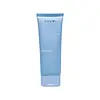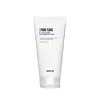What's inside
What's inside
 Key Ingredients
Key Ingredients

 Benefits
Benefits

 Concerns
Concerns

 Ingredients Side-by-side
Ingredients Side-by-side

Water
Skin ConditioningGlycerin
HumectantCoco-Betaine
CleansingBetaine
HumectantXanthan Gum
EmulsifyingSodium Chloride
MaskingCoco-Glucoside
CleansingCaprylyl Glycol
EmollientGlyceryl Caprylate
EmollientDecyl Glucoside
CleansingButylene Glycol
HumectantSodium Cocoyl Isethionate
CleansingDisodium EDTA
Panthenol
Skin Conditioning1,2-Hexanediol
Skin ConditioningAnthemis Nobilis Flower Extract
MaskingCitric Acid
BufferingQuillaja Saponaria Bark Extract
CleansingAllantoin
Skin ConditioningCaffeine
Skin ConditioningHelianthus Annuus Seed Oil
EmollientCamellia Sinensis Leaf Extract
AntimicrobialSaccharomyces/Xylinum/Black Tea Ferment
Skin ConditioningAgrimonia Eupatoria Extract
AstringentPortulaca Oleracea Extract
Skin ConditioningMelaleuca Alternifolia Leaf Extract
PerfumingPhenoxyethanol
PreservativeHydroxyethylcellulose
Emulsion StabilisingPotassium Sorbate
PreservativeWater, Glycerin, Coco-Betaine, Betaine, Xanthan Gum, Sodium Chloride, Coco-Glucoside, Caprylyl Glycol, Glyceryl Caprylate, Decyl Glucoside, Butylene Glycol, Sodium Cocoyl Isethionate, Disodium EDTA, Panthenol, 1,2-Hexanediol, Anthemis Nobilis Flower Extract, Citric Acid, Quillaja Saponaria Bark Extract, Allantoin, Caffeine, Helianthus Annuus Seed Oil, Camellia Sinensis Leaf Extract, Saccharomyces/Xylinum/Black Tea Ferment, Agrimonia Eupatoria Extract, Portulaca Oleracea Extract, Melaleuca Alternifolia Leaf Extract, Phenoxyethanol, Hydroxyethylcellulose, Potassium Sorbate
Water
Skin ConditioningSodium Cocoyl Isethionate
CleansingGlycerin
HumectantSodium Lauroyl Glutamate
Hydroxypropyl Starch Phosphate
1,2-Hexanediol
Skin ConditioningPotassium Cocoyl Glycinate
Carica Papaya Fruit Extract
Skin ConditioningPrunus Mume Fruit Extract
HumectantMalus Domestica Fruit Extract
AntioxidantVitis Vinifera Fruit Extract
Skin ConditioningPotassium Cocoate
EmulsifyingEthylhexylglycerin
Skin ConditioningDisodium EDTA
Melia Azadirachta Leaf Extract
Skin ConditioningAllantoin
Skin ConditioningMoringa Oleifera Seed Extract
Skin ConditioningCamellia Sinensis Leaf Extract
AntimicrobialMelia Azadirachta Flower Extract
Skin ConditioningFicus Carica Fruit Extract
HumectantGaultheria Procumbens Leaf Extract
PerfumingMonarda Didyma Leaf Extract
Skin ConditioningMentha Arvensis Leaf Extract
MaskingAcacia Concinna Fruit Extract
Skin ConditioningButylene Glycol
HumectantQuillaja Saponaria Bark Extract
CleansingSaponaria Officinalis Leaf Extract
AntimicrobialSapindus Trifoliatus Fruit Extract
Skin ConditioningSapindus Mukorossi Fruit Extract
Skin ConditioningCharcoal Powder
AbrasivePanthenol
Skin ConditioningCitric Acid
BufferingPolyquaternium-67
Water, Sodium Cocoyl Isethionate, Glycerin, Sodium Lauroyl Glutamate, Hydroxypropyl Starch Phosphate, 1,2-Hexanediol, Potassium Cocoyl Glycinate, Carica Papaya Fruit Extract, Prunus Mume Fruit Extract, Malus Domestica Fruit Extract, Vitis Vinifera Fruit Extract, Potassium Cocoate, Ethylhexylglycerin, Disodium EDTA, Melia Azadirachta Leaf Extract, Allantoin, Moringa Oleifera Seed Extract, Camellia Sinensis Leaf Extract, Melia Azadirachta Flower Extract, Ficus Carica Fruit Extract, Gaultheria Procumbens Leaf Extract, Monarda Didyma Leaf Extract, Mentha Arvensis Leaf Extract, Acacia Concinna Fruit Extract, Butylene Glycol, Quillaja Saponaria Bark Extract, Saponaria Officinalis Leaf Extract, Sapindus Trifoliatus Fruit Extract, Sapindus Mukorossi Fruit Extract, Charcoal Powder, Panthenol, Citric Acid, Polyquaternium-67
 Reviews
Reviews

Ingredients Explained
These ingredients are found in both products.
Ingredients higher up in an ingredient list are typically present in a larger amount.
1,2-Hexanediol is a synthetic liquid and another multi-functional powerhouse.
It is a:
- Humectant, drawing moisture into the skin
- Emollient, helping to soften skin
- Solvent, dispersing and stabilizing formulas
- Preservative booster, enhancing the antimicrobial activity of other preservatives
Allantoin is a soothing ingredient known for its protective and moisturizingg properties. Because of this, it is often added to products with strong active ingredients.
Studies show higher concentrations of this ingredient can promote wound healing.
Though it can be derived from the comfrey plant, allantoin is produced synthetically for cosmetic products to ensure purity.
Learn more about AllantoinButylene Glycol (or BG) is used within cosmetic products for a few different reasons:
Overall, Butylene Glycol is a safe and well-rounded ingredient that works well with other ingredients.
Though this ingredient works well with most skin types, some people with sensitive skin may experience a reaction such as allergic rashes, closed comedones, or itchiness.
Learn more about Butylene GlycolCamellia Sinensis Leaf Extract is derived from the leaves of the tea plant. Black tea, green tea, and oolong tea are all harvested from this plant.
This ingredient has many skin benefits:
This ingredient contains polyphenols, a strong antioxidant. Antioxidants help fight off molecules that damage skin cells.
On top of that, the antioxidants in green tea neutralize free-radicals from the sun. This gives the skin some extra UV protection, but should not replace sunscreen.
Many components of tea have anti-inflammatory properties.
Polyphenols and L-theanine help soothe the skin and reduce irritation. The caffeine in Camellia Sinensis Leaf Extract helps calm inflamed blood vessels.
Other compounds found in tea include: Vitamin Bs, linoleic acid, magnesium, calcium, iron, and zinc.
Research has shown both drinking Camellia Sinensis Leaf Tea and applying it to the skin can help boost skin elasticity and hydration. Studies also show using tea extract may reduce sebum, or oil, production.
Learn more about Camellia Sinensis Leaf ExtractCitric Acid is an alpha hydroxy acid (AHA) naturally found in citrus fruits like oranges, lemons, and limes.
Like other AHAs, citric acid can exfoliate skin by breaking down the bonds that hold dead skin cells together. This helps reveal smoother and brighter skin underneath.
However, this exfoliating effect only happens at high concentrations (20%) which can be hard to find in cosmetic products.
Due to this, citric acid is usually included in small amounts as a pH adjuster. This helps keep products slightly more acidic and compatible with skin's natural pH.
In skincare formulas, citric acid can:
While it can provide some skin benefits, research shows lactic acid and glycolic acid are generally more effective and less irritating exfoliants.
Most citric acid used in skincare today is made by fermenting sugars (usually from molasses). This synthetic version is identical to the natural citrus form but easier to stabilize and use in formulations.
Read more about some other popular AHA's here:
Learn more about Citric AcidDisodium EDTA plays a role in making products more stable by aiding other preservatives.
It is a chelating agent, meaning it neutralizes metal ions that may be found in a product.
Disodium EDTA is a salt of edetic acid and is found to be safe in cosmetic ingredients.
Learn more about Disodium EDTAGlycerin is already naturally found in your skin. It helps moisturize and protect your skin.
A study from 2016 found glycerin to be more effective as a humectant than AHAs and hyaluronic acid.
As a humectant, it helps the skin stay hydrated by pulling moisture to your skin. The low molecular weight of glycerin allows it to pull moisture into the deeper layers of your skin.
Hydrated skin improves your skin barrier; Your skin barrier helps protect against irritants and bacteria.
Glycerin has also been found to have antimicrobial and antiviral properties. Due to these properties, glycerin is often used in wound and burn treatments.
In cosmetics, glycerin is usually derived from plants such as soybean or palm. However, it can also be sourced from animals, such as tallow or animal fat.
This ingredient is organic, colorless, odorless, and non-toxic.
Glycerin is the name for this ingredient in American English. British English uses Glycerol/Glycerine.
Learn more about GlycerinPanthenol is a common ingredient that helps hydrate and soothe the skin. It is found naturally in our skin and hair.
There are two forms of panthenol: D and L.
D-panthenol is also known as dexpanthenol. Most cosmetics use dexpanthenol or a mixture of D and L-panthenol.
Panthenol is famous due to its ability to go deeper into the skin's layers. Using this ingredient has numerous pros (and no cons):
Like hyaluronic acid, panthenol is a humectant. Humectants are able to bind and hold large amounts of water to keep skin hydrated.
This ingredient works well for wound healing. It works by increasing tissue in the wound and helps close open wounds.
Once oxidized, panthenol converts to pantothenic acid. Panthothenic acid is found in all living cells.
This ingredient is also referred to as pro-vitamin B5.
Learn more about PanthenolWe don't have a description for Quillaja Saponaria Bark Extract yet.
Sodium cocoyl isethionate is a natural ingredient from coconut oil. It is an ultra gentle cleanser that gives a nice foam without drying the skin or impacting the skin barrier.
The amount of foam created depends on the amount of sodium cocoyl isethionate used in the product.
This ingredient also helps improve the spreadability of a product.
Learn more about Sodium Cocoyl IsethionateWater. It's the most common cosmetic ingredient of all. You'll usually see it at the top of ingredient lists, meaning that it makes up the largest part of the product.
So why is it so popular? Water most often acts as a solvent - this means that it helps dissolve other ingredients into the formulation.
You'll also recognize water as that liquid we all need to stay alive. If you see this, drink a glass of water. Stay hydrated!
Learn more about Water